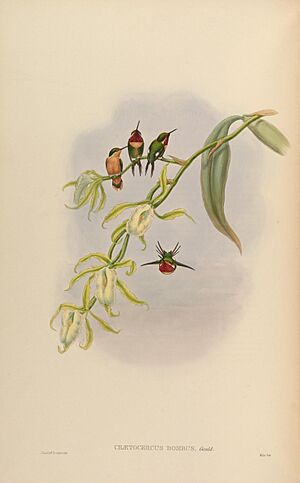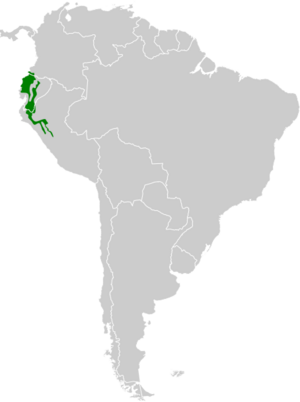Little woodstar facts for kids
Quick facts for kids Little woodstar |
|
|---|---|
 |
|
| Conservation status | |
| Scientific classification | |
| Genus: |
Chaetocercus
|
| Species: |
bombus
|
 |
|
| Synonyms | |
|
Acestrura bombus |
|
The little woodstar (Chaetocercus bombus) is a tiny hummingbird found in South America. People in South America sometimes call it estrellita chica, which means "little star". This bird is considered a Near Threatened species. It lives in countries like Colombia, Ecuador, and Peru.
Contents
About Its Name
Scientists group living things to understand them better. The little woodstar belongs to a group of hummingbirds called Chaetocercus. Before, it was in a different group called Acestrura. But scientists decided to move it to its current group in the late 1900s. This bird is the only one of its kind in its species group.
What It Looks Like
The little woodstar is a very small bird, only about 6 to 7 centimeters (2.4 to 2.8 inches) long. Both male and female birds have a straight, black beak.
Male Little Woodstar
The male bird is mostly a dark, shiny blue-green color. It has a light, buffy white stripe behind its eye. This stripe curves down to meet its light-colored chest. The male also has a bright, rosy red patch on its throat, called a gorget. Its tail is forked, like a "V" shape. The outer feathers of its tail are mostly just bare shafts, with almost no feathery parts.
Female Little Woodstar
The female bird is bronzy green on its back. Its belly is mostly a cinnamon color. The sides of its body and under its tail are a tawny (light brownish-orange) color. The female's tail is rounded, not forked. It is tawny with a black bar near the end.
Where It Lives
The little woodstar can be found in a few different places. It lives in the very southwest part of Colombia. From there, it goes through western Ecuador and into northern Peru. You can also find it in some separate areas in eastern Ecuador and north-central Peru.
This hummingbird likes to live where two types of forests meet: semi-humid and humid forests that lose their leaves in certain seasons. In western Ecuador, it lives from sea level up to about 2,300 meters (7,500 feet) high. In eastern Ecuador and Peru, it prefers higher places, between 900 and 3,000 meters (3,000 to 9,800 feet) high.
How It Behaves
Movement
Scientists believe the little woodstar mostly stays in one area. However, it might move up and down mountains depending on the season.
Feeding
The little woodstar looks for food from close to the ground up to the middle parts of the forest. It visits many different kinds of flowering plants and trees to find nectar. We don't know much about exactly how it finds its food. But scientists think it acts like its close relative, the white-bellied woodstar. That bird is small and flies slowly, almost like a bumblebee. This allows it to feed in areas that other, larger hummingbirds might try to protect.
Reproduction
Scientists do not yet know much about the little woodstar's breeding habits or life cycle.
Sounds It Makes
The song of the little woodstar is thought to be a mix of different sounds. It includes "chips," "twitters," and "buzzy notes." It sounds like "tsitsitsi..tzzeee-tzzeee..chichip." When it's feeding or hovering, it makes a single dry "chip" or a doubled "chichip" sound. When it's interacting with other hummingbirds, it makes a squeaky sound like "kswee-kswee-ti-ti-ti."
Its Status
The IUCN is a group that checks on how safe different animal species are. They first said the little woodstar was Threatened. Then, in 1994, they changed its status to Endangered. In 2000, it was listed as Vulnerable. Finally, in 2021, it was changed to Near Threatened.
This bird lives in a somewhat small area, and its population is spread out. There are an estimated 5,000 to 20,000 adult little woodstars left. Their numbers are believed to be going down. The biggest threat to this bird is the ongoing loss of its forest home. Forests are being cut down for wood, turned into farms, used for new towns, and for mining.



